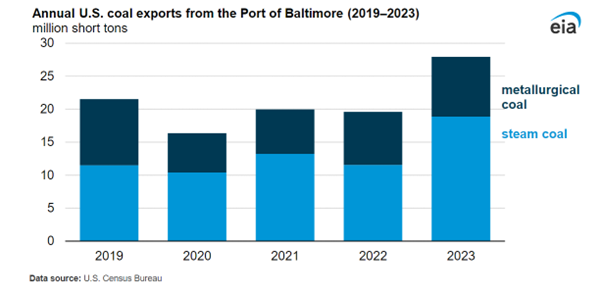
The U.S. Energy Information Administration warned last week in a market analysis that the interruption in operations in Baltimore may affect the volume of exports this year.
The collapse of the Francis Scott Key Bridge into the Patapsco River on March 26 has temporarily halted all shipping traffic from the Port of Baltimore.
The port is the second-largest exporting hub for coal in the United States, accounting for 28% of total coal exports in 2023, according to Census Bureau data.
It is second only to Norfolk, Virgina, also known as Hampton Roads.
How much coal moves through the Port of Baltimore?
In three of the past five years, annual coal exports from the Port of Baltimore totaled around 20 million short tons, with the only exception occurring in 2020 when the reaction to the COVID-19 pandemic dampened coal demand worldwide.
Exports from Baltimore surged to 28 million short tons in 2023, mainly because of growing demand for U.S. coal in Asia.
Even before the port’s closure, it was expected much slower growth in total U.S. coal exports in 2024, of just 1%.
There are two full-service terminals that receive, store, and load coal onto ocean-going vessels at the Port of Baltimore: the Curtis Bay Coal Piers served by the CSX Railroad and the CONSOL Energy Baltimore Marine terminal served by both the CSX and Norfolk Southern Railroads.
An attractive feature of the Port of Baltimore is its proximity to the northern Appalachia coal fields in western Pennsylvania and northern West Virginia.
Mines in this region produce both premium quality metallurgical coal and steam coal with a high heat content.
Steam coal, coal that is used mostly for electric power generation and industrial heating, is the dominant type of coal exported from the Port of Baltimore.
Those shipments averaged around 12 million short tons from 2019 to 2022 before surging to 19 million short tons in 2023.
Exports of metallurgical coal from Baltimore, or that used as a raw material in steel production, also are important, ranging from 6 million short tons to 10 million short tons from 2019 to 2023.
Other nearby ports, most notably Hampton Roads, have additional capacity to export coal, although factors including coal quality, pricing, and scheduling will affect how easily companies can switch to exporting from another port.
The top recipient of U.S. steam coal shipped from Baltimore by far over the past five years has been India, where the brick manufacturing industry has been a major customer.
Other major recipients for steam coal from Baltimore include several European countries that are reached by ports in the Netherlands.
Smaller markets include customers in the Dominican Republic, Canada, and Egypt.
Exports of metallurgical coal from the Port of Baltimore within the last five years went to several Asian countries.
The top recipient in 2023 was Japan, which received 28% of the metallurgical coal shipped through the port of Baltimore.
The next two major recipients of this coal over the last five years were China and South Korea. Multiple countries in Europe also receive metallurgical coal exported from the Port of Baltimore to the Netherlands, as do Brazil and Argentina.
What other energy products are affected by the port’s closure?
As it is revealed by the U.S. Energy Information Administration, a limited amount of refined petroleum products are imported into the Port of Baltimore.
Biodiesel, specifically biodiesel feedstock and other edible oils, are the largest refined petroleum product import with an average of 3,000 barrels per day (b/d) in 2023, mostly from Central America and Western Europe.
Other petroleum-derived products, such as fertilizers and other chemicals, are also imported. Baltimore imports the most asphalt of any U.S. port, about 4,000 b/d last year, with almost all imports originating from Canada.
Asphalt is made from crude oil and is commonly used for roadways and roofing.
“Since the port is a major transit point for freight and bulk vessels, we expect bunker fuel consumption to decrease,” says the U.S. Energy Information Administration.
Baltimore imports the most urea ammonium nitrate on the U.S. Atlantic Coast, about 2,000 b/d in 2023, and the fourth most of all U.S. ports.
Urea ammonium nitrate is a common liquid fertilizer, mostly imported from Russia.
The Port of Baltimore is the closest coastal port to Midwestern markets, which are a major source of agricultural demand.
Other ports on the U.S. Atlantic Coast can also import asphalt, such as Providence, Rhode Island; New York, New York; and Wilmington, North Carolina.
Other ports on the Atlantic Coast that can import urea ammonium nitrate are Norfolk, Virginia, and Wilmington, North Carolina.
Other, more widely used petroleum products are less affected. According to ship tracking data, there was one shipment of gasoline into the Port of Baltimore in 2023, and there were three petroleum-related export cargos in all of 2023.
Source: U.S. Energy Information Administration (EIA) / Principal contributors: Jonathan Church, Mark Morey, Josh Eiermann.



